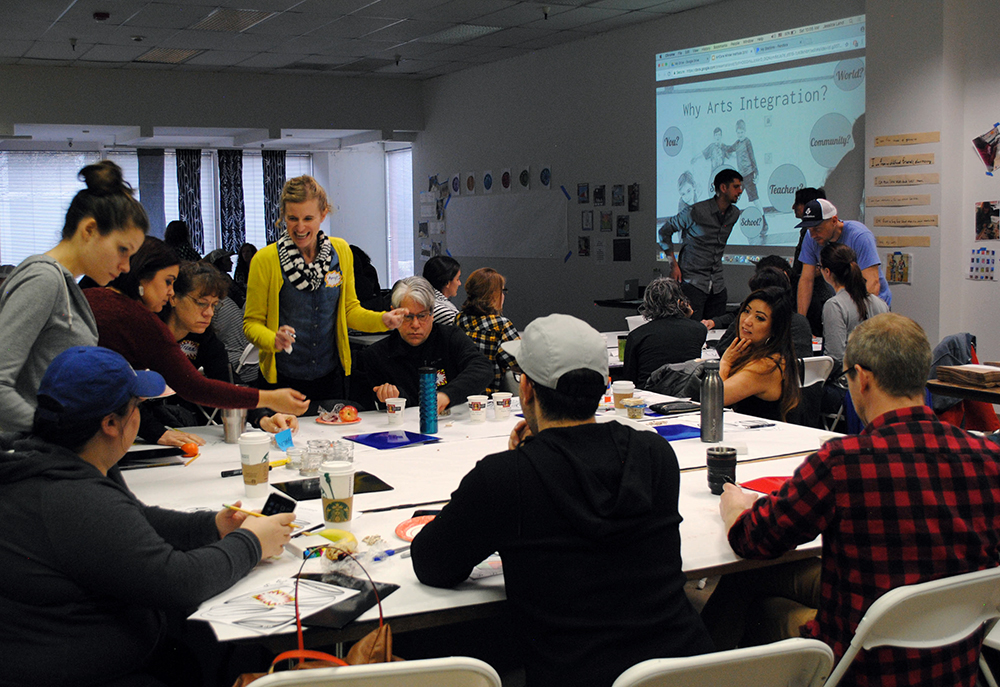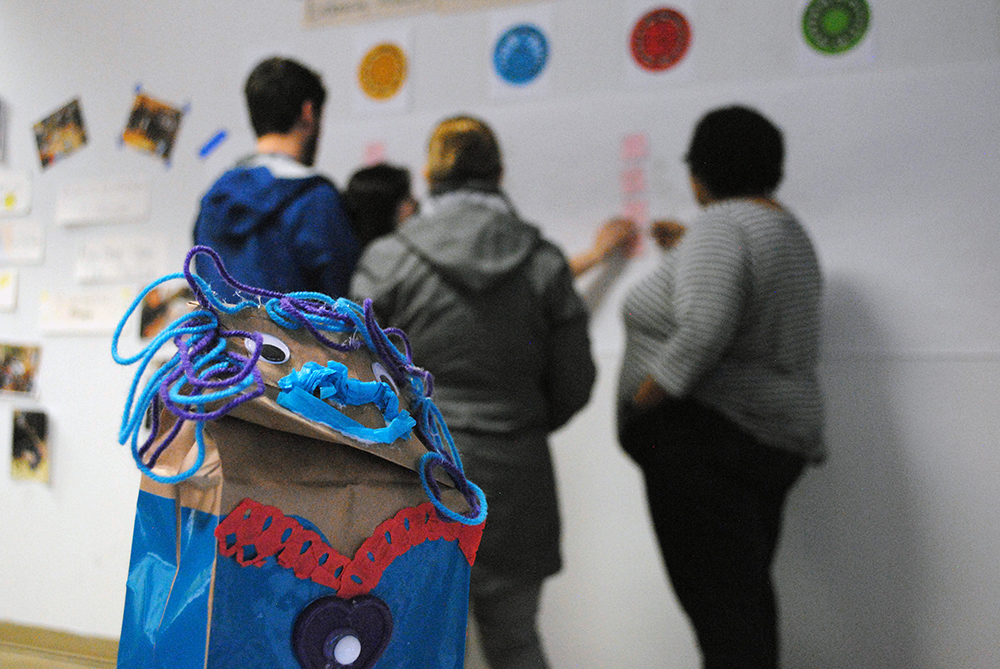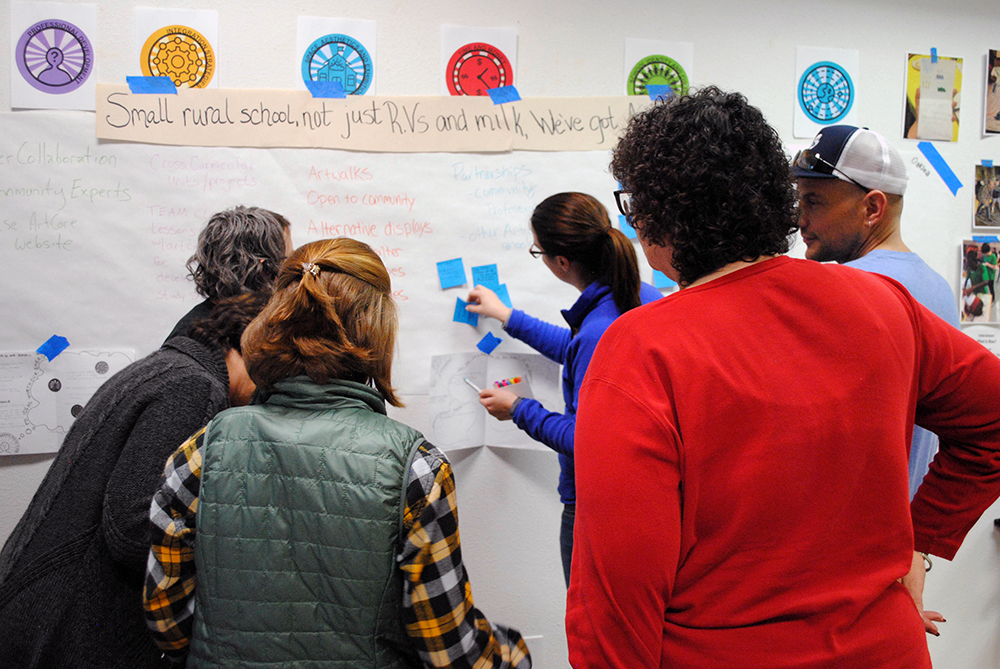Winter Institute 2018 - Planning for Sustainability
The creative energy of the 38 teachers who attended ArtCore’s Winter Institute (WI) in February 2018 has become new fuel for integrated learning at each of the five schools.
When asked why this work matters—to themselves, their students, their communities, and the world—WI participants’ responses articulated the many ways learning through the arts breathes life into their professional practice, their schools, and beyond. While each school has its unique needs, limitations, and assets, participants from across schools agree that arts-integrated work is fundamental to their learners’ growth as whole humans. Throughout the morning, they created an audioscape of their reasons for doing this work. Hear their voices here in this audio clip, or read selections at the bottom of this page.
All day, teachers journeyed through a dynamic, multi-media design process that was analytical, reflective, imaginative, visionary, empowering, challenging and, ultimately, inspiring and rejuvenating. With the Oregon Contemporary Theater as our workspace, theater metaphors set the stage for a shift in focus from the work of the past three years—now referred to as “Act I”—to the next eight months and beyond: “Acts II & III”.
Using a ‘Zine format for note-taking, participants in break-out sessions explored opportunities across 5 fundamental resources:
- school culture, identity & ritual;
- instructional strategies & curriculum;
- teacher professional development;
- physical space, aesthetics & exhibits; and
- time & money.
Throughout the day, each school team identified the particular ways these resources can be leveraged to support arts integration at their school.
Participants added themselves to this list after a visual arts exploration that asked each person to make a hand-puppet that represented his or her creative self. During this exercise teachers were encouraged to own their creativity and to view themselves as artists of pedagogy. They identified mindsets and strengths that people sometimes don’t directly associate with creativity such as being flexible, reflective, risk-taking, and having a sense of humor.
By the end of the day, each school had outlined its own schema for sustainability. They had prioritized action items for each resource category and crafted a future newspaper headline describing their school sometime during “Act III.”
Oaklea M.S. teachers recommitted to defining their school culture in terms of the arts and Studio Habits of Mind. Their headline reads: Small rural school, not just RVs and milk, We’ve got Art. Hamlin M.S. has committed to STEAM and sees the potential of arts integration to reach students across content areas. Their headline was Defining STEAM: Cross-curricular units bring community together.
At the end of the day, when everyone gathered in the theater to hear the audioscape of their Why’s, the group shifted from from creators to audience. As they sat in audience with their own voices, the power of the work became audible.
And when the participants of the Winter Institute left the theater, they carried this authentic and integrated work with them.
Selections from the "ArtCore - The Why" audioscape:
“Integrating art into my classroom...helps engage students who don’t always necessarily feel understood in a conventional setting.”
“I practice arts integration as an offering for my students to feel empowered and connect with their cultural identity.”
“Creative endeavors produce meaning and light in our world. Art channels challenges and darkness into productive energy that inevitably bring individuals into community.”
“The world needs more art. It’s a language that can transcend physical borders and cultural divides.”
“Arts integration...offers opportunities for our students to think through challenges in new and horizon-expanding ways.”
“I like using it to find humor, to examine issues closely, deeply, from different angles, and to remember the beauty within living imperfectly.”
“Students can explore and establish their own identity.”
“Art has always had an uplifting effect on poor communities around the US and I’ve seen these affects also on my students as art continues to be integrated. It’s giving my students a voice that they’ve never had before and a chance to put themselves into the learning and to take ownership of their education. And, they take that excitement home...to their families. I’ve seen parents come in excited about what the kids are doing and it creates kind of a stirring of hope. That’s what ArtCore gives to the whole city.”
“Art integration...connects students to other cultures they may not be aware of.”
“Art encourages empathy.”
“I have seen kids express themselves in different ways and seen their confidence and enthusiasm grow.”
“I constantly think of...how to increase engagement. Using ArtCore strategies definitely helped with that in multiple ways, including student choice and expression....Especially being a math teacher, integrating art into my curriculum helps with that stagnant routine that sometimes we fall into.”
“My students have a mindset that they can’t do things. The Studio Habits of Mind helped break that mindset: perseverance and engage & persist.”
“My Why for the world: to be creative, to create creative resilient well-rounded understanding multi-dimensional multi-perspective multi-talented open-minded humanity, to make the world a better place.”












